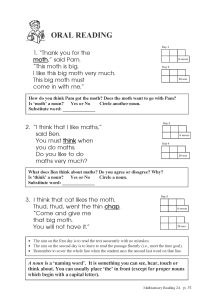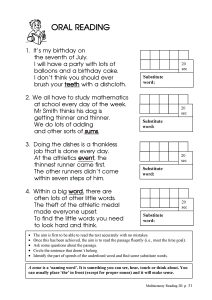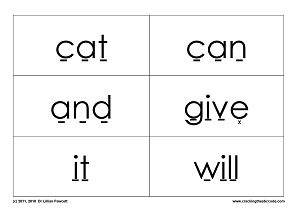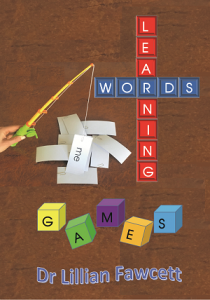Below is a sample of the Oral Reading section of the Cracking the ABC Code Multisensory Reading Level 2 Program


The Oral Reading section has been developed to increase students’ ability to rapidly and accurately decode text. The text has been divided into eye span lengths to encourage students to look at chunks of text and move away from a word by word focus. A fluent oral reader decodes the text ahead of the words that are being spoken. To develop this skill, you are asked to place a cardboard strip above the line being read and to cover the line completely once the student says the second last word.
Each passage includes vocabulary from the 10 list words plus other words containing the grapheme being learned. Using the same words provides additional practice in the learning and retention process of both the words and the grapheme, as well as further developing students’ understanding of the words by placing them in context.


It is recommended that two copies of the vocabulary cards are printed off onto cardboard. Focus on 10 words at a time. Play games like ‘Go Fish’ and ‘Patience’ to help students learn the words.
1. Students are required to complete one oral reading exercise each day.
The student reads through the passage.
- Work out unknown words.
- Underline unknown words.
- Practice reading the underlined words.
2. The student reads the passage and the time is recorded in the boxes to the side. Meeting time goals assists in the development of processing speed which results in increases in students’ ability to read fluently and accurately (see Sukhram, 2008; Vadasy & Sanders, 2008, Lee & Yoon, 2015, Stevens et al., 2017).
3. After the time target is reached, students reread the passage silently (without timing) to ensure there is full comprehension of the text.
Effective reading requires understanding as well as decoding. Thus you are required to ask students two or three comprehension questions about the passage to assess their understanding. Students should be encouraged to refer back to the text to both find and justify their answer and to answer using full sentences (e.g., Question:What did Raymond feed his pet snake? Answer: Raymond fed his pet snake cake and lemonade).
In addition, in the Multisensory Reading Level 2B program, each passage contains one sentence that doesn’t address the same subject matter as the other sentences. Identifying the sentence that does not belong encourages students to move beyond a basic understanding of the text and to make inferential judgements.
4. In the final task students are required to identify whether the underlined word is a verb, noun, adverb, adjective, etc. and find meaningful substitute words (these words do not have to have the same meaning but just make sense from a grammatical perspective). This exercise is designed to develop student’ understanding of the grammatical structure of English.
References
Lee, J., & Yoon, S. (2015). The effects of repeated reading on reading fluency for students with reading disabilities; A meta-analysis. Journal of Learning Disability. 50 (2), 213 – 224.
Stevens, E.A., Melodee A. Walker, M.A., & Vaughn, S. (2017). The effects of reading fluency interventions on the reading fluency and reading comprehension performance of elementary students with learning disabilities. Journal of Learning Disabilities, 50(5), 576–590.
Sukhram, D. (2008). The effects of oral repeated reading with and without corrective feedback on the fluency and comprehension of narrative and expository text for struggling readers. Ph.D., University of Illinois: Urbana-Champaign.
Vadasy, P., & Sanders, E. (2008). Benefits of repeated reading intervention for low-achieving fourth and fifth grade students, Remedial and Special Education, 29 (4) 235-250



If you have any questions or would like to discuss your child or student’s particular literacy problem, please contact Lillian.

